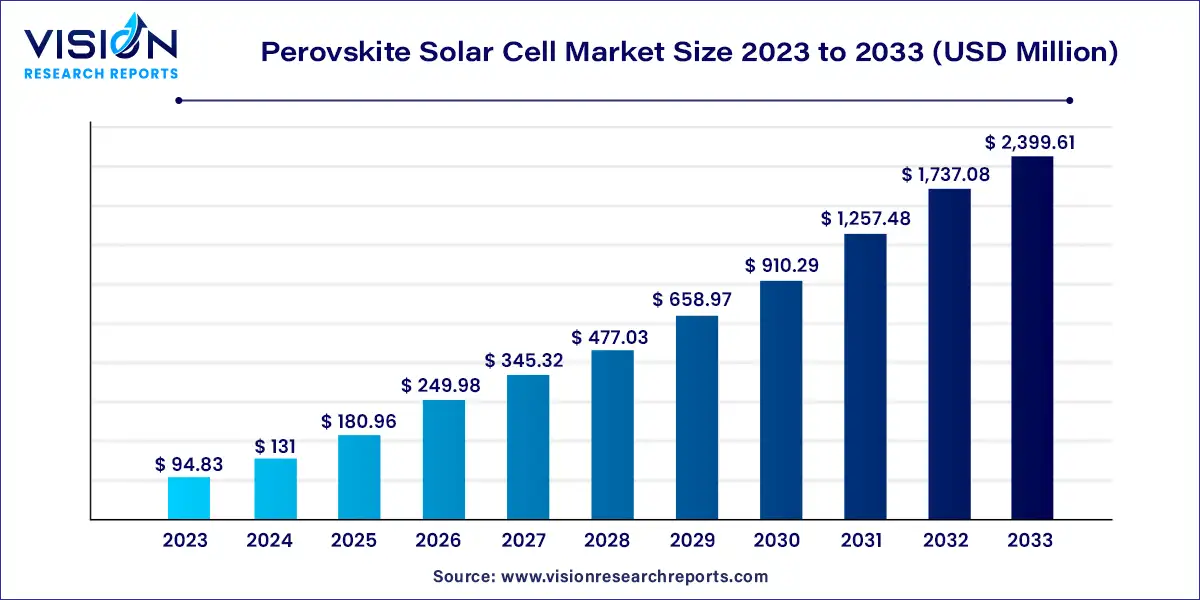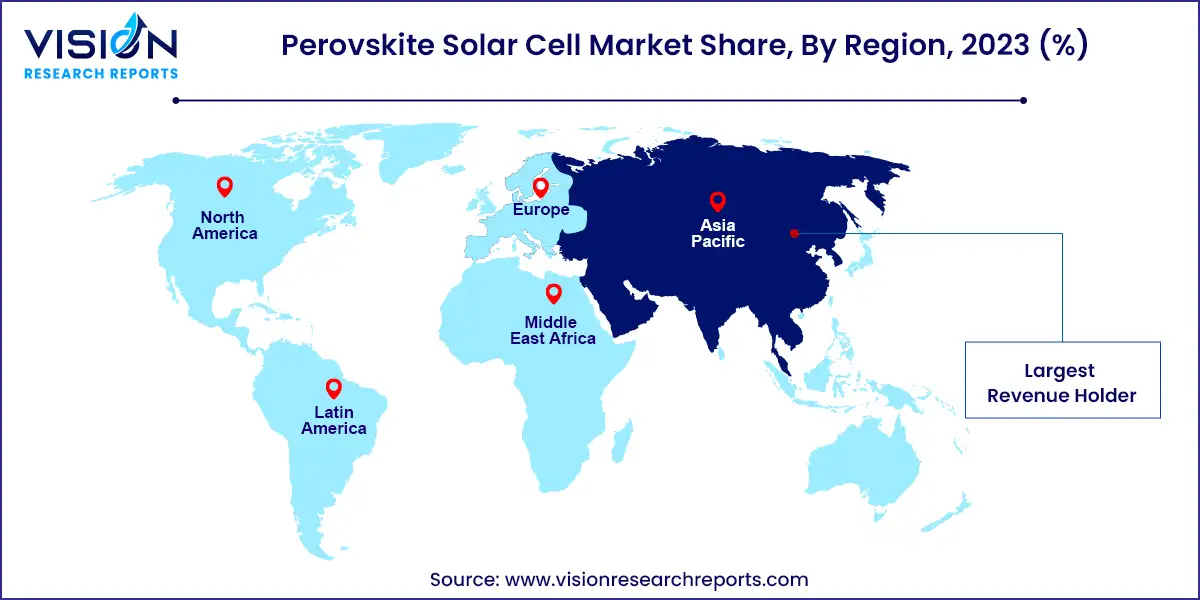The global perovskite solar cell market size was estimated at around USD 94.83 million in 2023 and it is projected to hit around USD 2,399.61 million by 2033, growing at a CAGR of 38.14% from 2024 to 2033.

The perovskite solar cell market is experiencing notable growth and attention within the renewable energy sector. Perovskite solar cells, characterized by their unique crystal structure, offer promising potential for efficient and cost-effective solar energy generation.
The growth of the perovskite solar cell market is driven by several an advancements in perovskite solar cell technology, particularly in improving efficiency and stability, have significantly boosted their attractiveness as a viable alternative to traditional silicon-based solar cells. Secondly, increasing investments in research and development initiatives aimed at enhancing perovskite solar cell performance have accelerated innovation and commercialization efforts in the industry. Thirdly, supportive government policies and incentives promoting renewable energy adoption have created a conducive environment for the growth of the perovskite solar cell market, driving demand from both residential and commercial sectors. Moreover, growing environmental awareness and concerns about climate change have led to a greater emphasis on sustainable energy solutions, further propelling the adoption of perovskite solar cells.
In 2023, planar perovskite solar cells dominated the revenue shares, and they are expected to continue experiencing significant revenue growth rates over the projected period. The layered structure sector has seen rapid expansion owing to its application in thin-film photoelectric structures and impressive electrical and optical properties. This type of cell can be manufactured without high-temperature methods and is utilized in mesoporous structures when the layer thickness is minimal.
By 2033, the market value for mesoporous perovskite solar cells is expected to surpass USD 1.2 billion due to their extensive application in product manufacturing and efficiency of over 21% in power conversion. The category of flat solar cells incorporating perovskite is anticipated to drive market expansion due to increasing demand.
With its rising demand across various applications, the inflexible modules segment is expected to claim a disproportionately large share of the market. Additionally, the flexible module market is poised to expand rapidly due to several technical advancements.
In 2023, the rigid perovskite-based solar cell market is projected to experience the fastest compound annual growth rate (CAGR), while the flexible perovskite-based solar cell sector is anticipated to have the largest proportion.
The Building Integrated Photovoltaics (BIPVs) sector is projected to dominate the major market segment due to the growing demand for solar cells using perovskite in constructing buildings and various construction materials like roofs, windows, and facades. By 2030, the consumer devices category, particularly portable media players, is expected to surpass the entire market in terms of growth.
The consumer technology sector is anticipated to demonstrate the highest compound annual growth rate (CAGR) during the forecast period, driven by the rising demand for wearable technology. However, the energy sector claimed the largest share in terms of revenue, comprising over two-fifths of the global perovskite solar panel industry. This dominance is attributed to the increasing demand for sustainable and renewable energy sources.
Mixed Perovskite Solar Cells (PSCs) are projected to capture the largest market share, accounting for approximately 52%. This dominance is attributed to their widespread use and versatility. Furthermore, Flexible PSCs are expected to experience the highest Compound Annual Growth Rate (CAGR) of approximately 29.9%. This growth is driven by increasing demand in wearable power sources and their integration into various architectural designs. Additionally, Flexible PSCs offer several advantages such as portability, flexibility, lightweight, and compatibility with non-standard electronic devices, further fueling their market expansion.
The revenue growth of the Asia Pacific industry is expected to significantly accelerate during the projection timeframe. This dominance is attributed to several factors, including rapid urbanization in the region, the increasing demand for alternative energy sources to reduce reliance on fossil fuels, and supportive government initiatives. Additionally, the Asia Pacific region leads the global industry in terms of revenue share.

Moreover, the region's market is bolstered by its well-established consumer electronics sector. In 2023, North America held the second-largest market share in the global crystalline solar cell market. This was driven by the region's robust automotive industry, rising demand from end-use sectors, and the presence of major market players competing in North American nations.
By Structure
By Method
By Application
By End-Use
By Type
By Region
 Cross-segment Market Size and Analysis for
Mentioned Segments
Cross-segment Market Size and Analysis for
Mentioned Segments
 Additional Company Profiles (Upto 5 With No Cost)
Additional Company Profiles (Upto 5 With No Cost)
 Additional Countries (Apart From Mentioned Countries)
Additional Countries (Apart From Mentioned Countries)
 Country/Region-specific Report
Country/Region-specific Report
 Go To Market Strategy
Go To Market Strategy
 Region Specific Market Dynamics
Region Specific Market Dynamics Region Level Market Share
Region Level Market Share Import Export Analysis
Import Export Analysis Production Analysis
Production Analysis Others
Others